NRAO eNews
Volume 8, Issue 1
28 January 2015
NRAO eNews
Volume 8, Issue 1 • 28 January 2015

Upcoming Events

AAAS 2015 Science Symposium
Feb 15, 2015 | San Jose, CA

NRAO Community Day at the Universidad Nacional Autónoma de México Morelia
Feb 26 - 27, 2015 | Morelia, Mexico

NRAO Community Day at the Florida Institute of Technology
Mar 9 - 10, 2015 | Melbourne, FL

2015 PHISCC Workshop: HI Surveys Get Real
Mar 16 - 18, 2015 | Rutgers University, NJ

Star and Planet Formation in the Southwest
Mar 23 - 26, 2015 | Oracle, AZ

NRAO Community Day at Star and Planet Formation in the Southwest
Mar 27, 2015 | Oracle, AZ

NRAO Community Day at the University of California at San Diego
Mar 31 - Apr 1, 2015 | San Diego, CA

NRAO Community Day at the Space Telescope Science Institute
Apr 13 - 14, 2015 | Baltimore, MD
Restoration of Page Charge Support
NRAO has had a longstanding policy of providing page charge support to authors affiliated with U.S. institutions publishing papers that report original observations utilizing the Very Large Array, Very Long Baseline Array, and/or the Green Bank Telescope, contain an original analysis of archival data from these instruments, and/or are based on a significant amount of previously unpublished data from these telescopes. Beginning in 2012, this policy was extended to include the Atacama Large Millimeter/submillimeter Array. The NRAO has been the only U.S. ground-based observatory to provide page charge support to its users in recent years. Unfortunately, as the result of a very challenging budget climate, we had to suspend page charge support for our user community in 2014.
We are pleased to inform you that for 2015, we are able to restore page charge support to our users under the terms outlined above. However, because resources remain limited, when requesting page charge support please provide a brief justification for the request. In some cases, we may be unable to provide requested support.
Additional information is available on-line. If you have questions, please contact the NRAO Librarian, Marsha Bishop via e-mail or phone (434-296-0254).
NRAO Community Days 2015
In advance of the ALMA Cycle 3 Call for Proposals, NRAO will be providing Community Day Events (CDEs) at a number of North American institutions. The goal of these CDEs is to provide users with the knowledge they need to carry out cutting-edge scientific research using NRAO facilities. We are particularly interested in reaching new users, so no experience with radio astronomy is required to participate!
NRAO CDEs are one to two day events designed in cooperation with host institutions across North America, and participation is free, no registration fees will be charged. These CDEs include science talks, an introduction to submillimeter interferometry, and hands-on workshops designed to assist you in proposal preparation, observation planning, and data reduction for ALMA Cycle 3. You will need to bring your laptop to participate in the hands-on sessions, and we will provide access to the free software that you can download, as well as the small dataset to be used in the demonstrations.
If you are interested in attending a Community Day Event, have a look for the one nearest you from the list below!
2015 Single-Dish & Interferometry Summer Schools
NRAO and National Astronomy and Ionosphere Center (NAIC) are organizing the eighth NAIC-NRAO summer school on single dish radio astronomy. For the first time, this school will be followed by a 3-day course on radio interferometry, including hands-on imaging and analysis of ALMA data.
The Single-Dish School will be held from 5-10 July 2015 at NRAO in Green Bank, WV. The school is intended to provide graduate students, post-docs, and experts in other fields of astronomy with both background knowledge and practical experience with the techniques and applications of single-dish radio astronomy. The School includes a series of lectures from experts in the field. Participants will also take part in a hands-on project using either the Arecibo Telescope or the Robert C. Byrd Green Bank Telescope (GBT). The hands-on component is a significant part of the program, allowing participants to make observations, analyze the data acquired, and interpret the results all during the course of the week.
The Interferometry School will take place 12-14 July 2015, also at NRAO – Green Bank. The Interferometry School will include two days of lectures on radio interferometry at a level appropriate for graduate students in astrophysics. The final day of the school will feature hands-on work to image and analyze ALMA data using the Common Astronomy Software Analysis (CASA) software package.
There will also be a North American interferometry summer school at Dominion Radio Astrophysical Observatory (DRAO) in Penticton, Canada on 17-21 August, organized by the Millimetre Astronomy Group at the National Research Council-Herzberg. More information will be available soon!
Participants are welcome to register for any or all of these schools. More information will be available in the next eNews, and registration will open in February.
NRAO Invites 2015 Jansky Lectureship Nominations
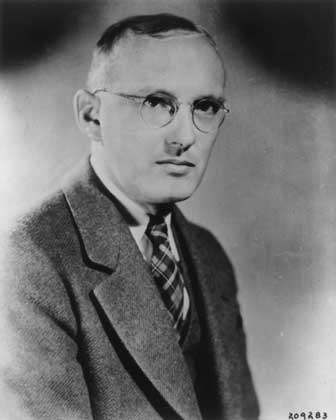
The National Radio Astronomy Observatory invites nominations for the 2015 Jansky Lectureship. The Karl G. Jansky Lectureship is an honor established by the Trustees of Associated Universities, Inc. to recognize outstanding contributions to the advancement and public appreciation of radio astronomy. First awarded in 1966, it is named in honor of Karl G. Jansky who first detected radio waves from a cosmic source. For more information, visit the Jansky Lectureship website.
Please send your nomination, including a concise justification for your choice, to J.J. Utley by Friday, 27 February 2015.ALMA Program Status
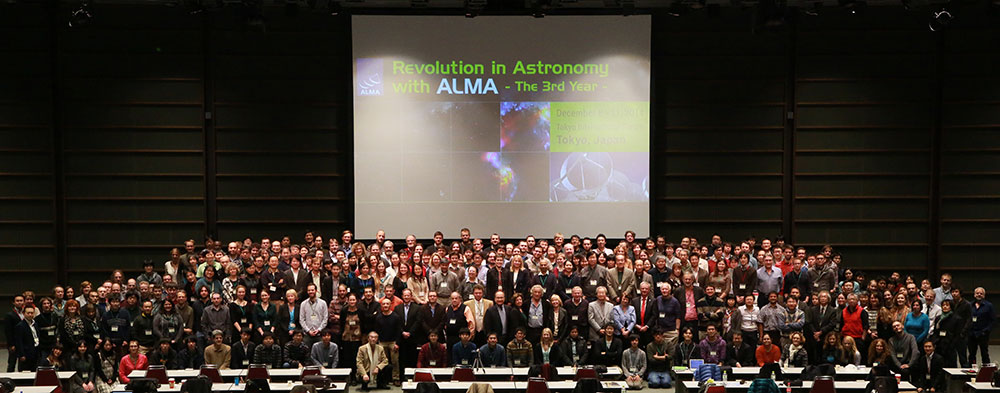
Attendees at Revolution in Astronomy with ALMA - The 3rd Year
[click to enlarge]
ALMA's antennas were moved into a compact configuration, a hybrid of C34-1 and C34-2, at the end of the long baseline campaign in late November 2014. Early Science programs using those arrays began 2 December. Five weeks of observing have been completed, as of this writing. Data collection rates have been excellent, with greater efficiency realized and increased numbers of available antennas. Projections show progress on schedule toward completion of Cycle 2 at the end of September 2015. Early Science will be paused 3 February 2015 for engineering on the array, and will resume 31 March 2015, as previously announced.
The pre-announcement for ALMA Cycle 3 proposals is available on the ALMA Science Portal. The ALMA capabilities that are anticipated to be available are described in the pre-announcement. The Cycle 3 Call for Proposals will be posted 25 March 2015 for a submission deadline of 23 April 2015. A goal of the North American ALMA Science Center (NAASC) is to provide PIs with non-problematic, completed Cycle 1 and 2 Observation Unit Sets (including Total Power data) prior to the Cycle 3 Call. We remind PIs that the NAASC supports data reduction visits to work with NRAO staff in Charlottesville, VA. The next ALMA data reduction tutorial will be scheduled after the Cycle 3 deadline.
In advance of the Cycle 3 deadline, NRAO Community Day Events (CDEs) are being planned for various locations around the United States. Further information regarding these events is available in the Events listings at the NRAO science website home page. Applications for hosting a CDE may be submitted until 15 February 2015; see the article about CDEs in the 4 December 2014 eNews for additional information and the on-line application.
From 8-11 December 2014, nearly 300 astronomers gathered in Tokyo for a science conference titled Revolution in Astronomy with ALMA - The 3rd Year. Numerous recent ALMA results were presented and discussed. One highlight was presentation of early results from the recent long baseline campaign. These results were also presented at the 225th American Astronomical Society (AAS) meeting in Seattle in early January, at which plans for public release of a number of datasets in early February were presented. An announcement will appear at the ALMA Science Portal soon. The Tokyo meeting presentations will comprise a volume of the Astronomical Society of the Pacific conference series that will appear later in the year.
ALMA Development Projects are reaching conclusion. The ALMA Optical Link Project has established a complete pathway for data transmission via fiber from the Array Operations Site (AOS) at Chajnantor to the Joint ALMA Observatory (JAO) offices in Santiago. Certification and integration are being finalized. A review of the ALMA Phasing Project was held in mid-December with a positive result. Early tests are ongoing and look promising. The first of the ALMA Band 5 receivers (163-211 GHz) will arrive at the ALMA Operations Support Facility (OSF) within the next several months. A new Call for ALMA Development Studies is expected from North America within a few weeks.
The NRAO - NAASC has two open scientific staff positions that are currently being advertised: a tenure-track astronomer position and one, possibly two, scientist track positions. The JAO is also seeking an Observatory Scientist.
VLA Sky Survey Update
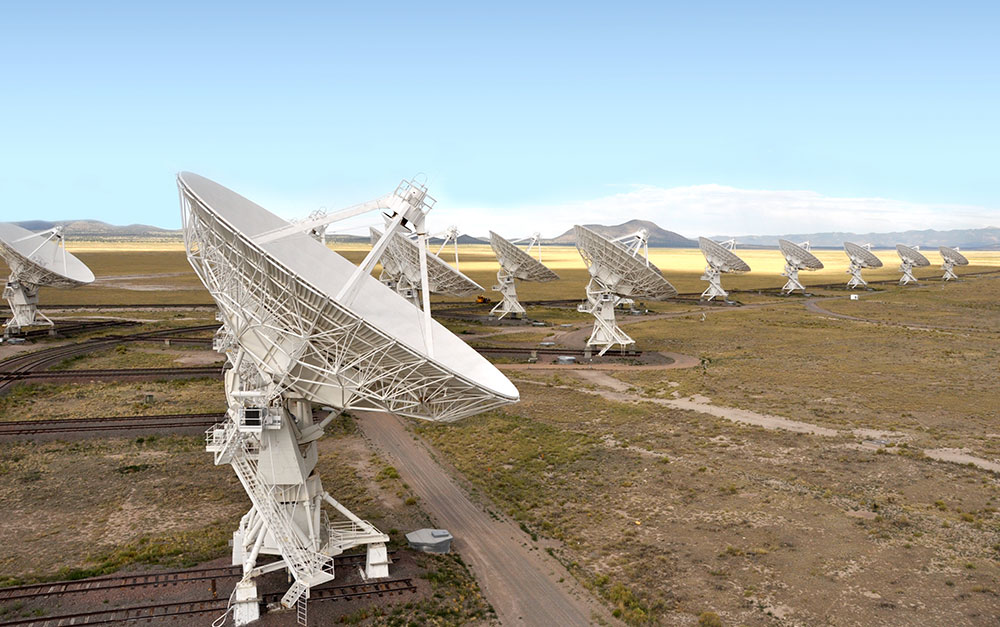
[click to enlarge]
The final version of the VLA Sky Survey (VLASS) proposal is now available on the NRAO VLASS wiki. This version reflects revisions made to the survey definition in response to NRAO scientific and technical reviews, and is the version that will be evaluated by the upcoming VLASS Community Review. A revised and updated Technical Implementation Plan will also be posted soon.
A period of open community comment on the VLASS proposal will extend through 22 February 2015. Instructions for how to submit comments on the proposal, may be found at the VLASS webpage. All community input received during this period of open comment will be made available to the Community Review Panel.
The VLASS Community Review will take place 4-6 March 2015, in Socorro, NM. The Review Panel will be charged with reviewing all aspects of the proposal, and making recommendations on how to proceed with the request. The Community Review Panel members are:
- Andrew Baker (Rutgers, Chair)
- Harry Ferguson (STScI)
- Jacqueline van Gorkom (Columbia)
- Jenny Greene (Princeton)
- Kelsey Johnson (UVA)
- Ryohei Kawabe (NAOJ)
- James Miller-Jones (Curtin)
- Luis Rodriguez (UNAM)
- Eva Schinnerer (MPIfA)
- Doug Scott (UBC)
- Fabian Walter (MPIfA)
- Belinda Wilkes (CfA)
- Rogier Windhorst (ASU)
If the VLASS proposal is approved, observing will start no earlier than Spring 2016. We look forward to further discussion with the community and the Review Panel regarding the scientific opportunities of a new VLA Sky Survey.
CASA Users Committee
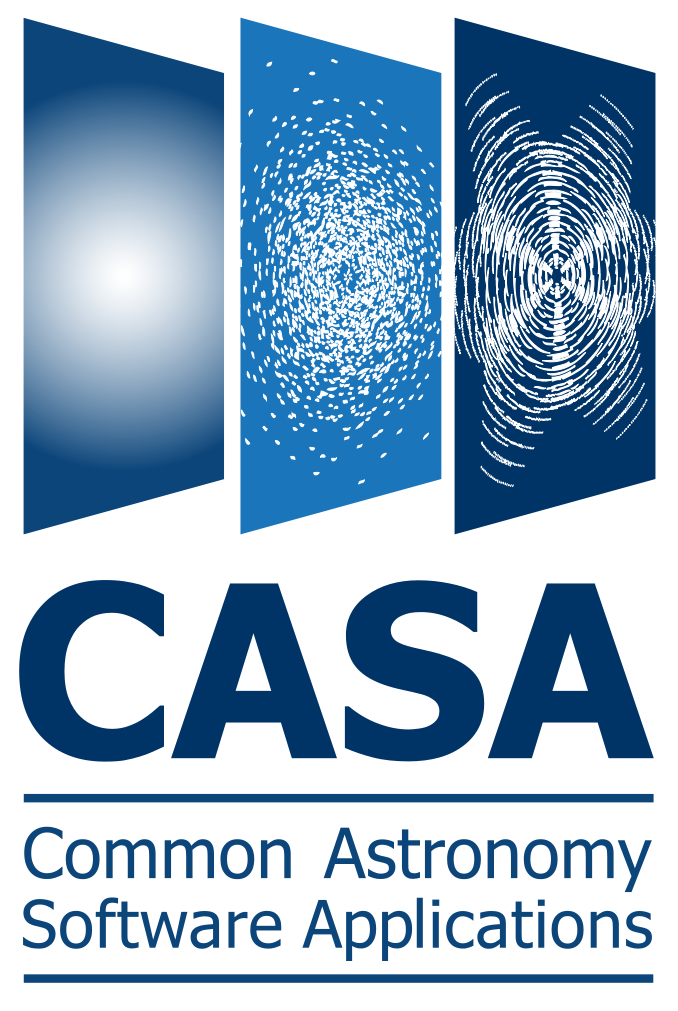
The CASA Users Committee (CUC) was established to provide advice on the user community perceptions of the Common Astronomy Software Applications package, primarily for ALMA and VLA observations. The CUC consists of ten members appointed by the science operations teams of the ALMA Executives, representing a wide variety of science interests and CASA use cases.
This group started quarterly telecons in April 2014. The first annual face-to-face meeting of the CUC with the CASA project team was held 22-23 September 2014 at NRAO – Socorro, where the participants engaged in lively discussions about ongoing developments, challenges, and future plans. The CUC delivered feedback on a suite of charges, including CASA capabilities, usability, reliability and performance, the relative priorities of functional areas, pipelines, remaining barriers to adoption and community input, and support for telescopes other than ALMA and VLA.
The resulting written report is available, along with a detailed response from the CASA project manager, at the CASA Public Wiki.
CASA 4.3.0 Release
We are pleased to announce the release 4.3.0 of the Common Astronomy Software Applications (CASA) package. CASA is being developed by NRAO, the European Southern Observatory, and the National Astronomical Observatory of Japan, and is used for the offline reduction and analysis of both ALMA and VLA data. CASA is fully scriptable. Full support is provided for ALMA and VLA but almost any data that can be written in uvfits format can be imported and reduced in CASA, including data acquired with the Combined Array for Research in Millimeter Astronomy (CARMA), the Submillimeter Array (SMA), and the Australia Telescope Compact Array (ATCA). CASA 4.3.0 is now available from the CASA homepage. Please follow the links to "Obtaining CASA".
Supported Operating Systems are:
- Linux (64bit): RedHat 5.11 & 6.6
- Mac OS: 10.8 (Mountain Lion)
Major new features include:
- New scheme for WEIGHTS that includes the initialization of WEIGHTS according to the integration time and bandwidth;
- Plotms improvements for multi-panel plots (MSs and calibration tables), overplotting, plotting multiple files, export of multi-page plots;
- New mode in gencal to create a caltable for ionospheric corrections;
- Graphical plotting of data for the feather task to combine low and high resolution images;
- New tasks for binning and smoothing images, including complex-valued images;
- Rotation measure calculation (rmfit); and
- New task sdbaseline2 for baseline subtraction, creation, and application of baseline table.
For a full list of new features, see the CASA 4.3 release notes.
We encourage CASA users and potential users to subscribe to:
Casa-announce for announcement of new releases, workshops, etc.; and
Casa-users for critical bugs and code updates.
If you have any questions, please consult the NRAO helpdesk. Address questions about ALMA to the ALMA Helpdesk. An online CASA discussion forum is open to all.
GBT Limits on Neutral Hydrogen in Dwarf Galaxies
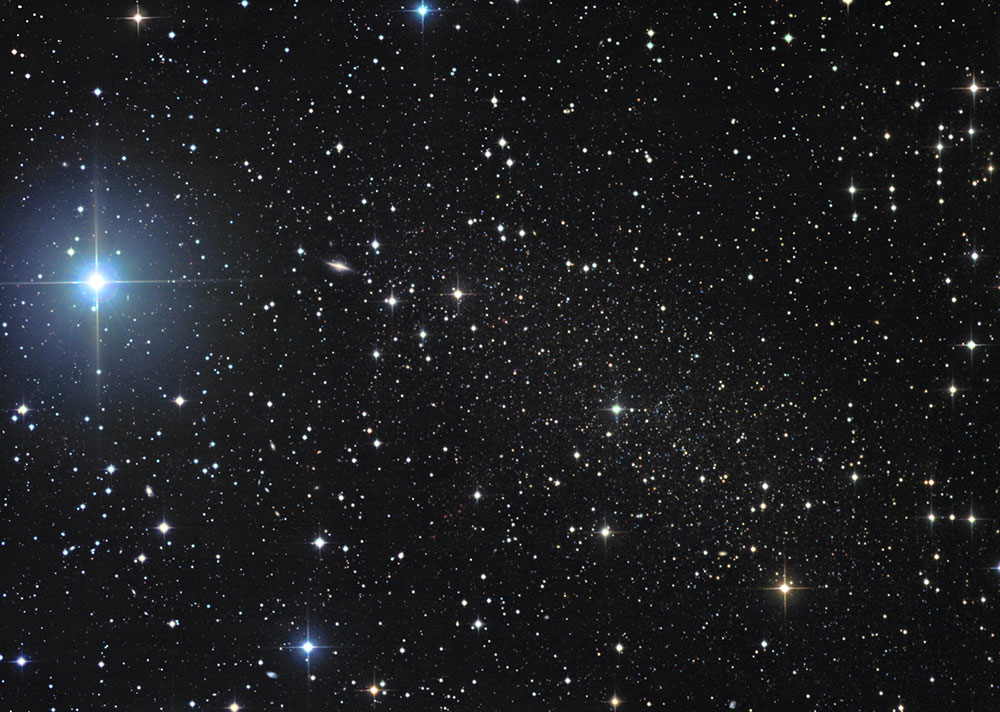
K. Spekkens/Capella Observatory
The dwarf spheroidal galaxy Segue I.
[click to enlarge]
Stars in galaxies are formed from the interstellar medium, and recycle material to their interstellar medium through stellar winds and mass loss after a star turns off the main sequence. The interstellar medium of a galaxy thus reflects its current ability to form stars, its history of stellar mass loss, and factors such as accretion, supernovae, and interactions.
The Milky Way is surrounded by a number of lower-mass dwarf spheroidal galaxies and it has long been known that those within the Milky Way’s virial radius, about 300 kpc, tend to be deficient in neutral hydrogen (HI) compared to dwarf galaxies at a greater distance. Because these galaxies lack the young, massive stars that are the progenitors of supernovae, this suggests that environmental factors, such as gas stripping through interaction with the Milky Way’s extended hot corona, may play an important role in their evolution.
Recent 21 cm HI observations using the NRAO Green Bank Telescope (GBT) have produced the most stringent limits to date on the presence of neutral gas in a set of nearby dwarf spheroidal galaxies, limits that are a factor of more than 20 below previous measurements.
The limits can be astonishingly small. GBT observations of the galaxy Seque I, which has a luminosity of 340 L⊙, limit the HI content to no more than 11 M⊙ (5σ limit). For the much larger Ursa Minor dwarf, with a luminosity of 2.8 x 105 L⊙, the 5σ limit on the HI mass is only 63 M⊙. The GBT observations show that five dwarfs have < 100 M⊙ of HI and several others have < 400 M⊙. For comparison, a “standard Spitzer” diffuse cloud in the Milky Way contains 400 M⊙ of HI.
The mass loss expected from stellar evolution in several of these galaxies exceeds the detection limit by more than a factor of 10. The Ursa Minor dwarf is particularly interesting, as its orbit takes it beyond the hot corona of the Milky Way for nearly 1 Gyr, during which time it should have accumulated 30 times more HI than the new limit. Thus, either the accumulating interstellar gas in these galaxies is not in the atomic phase, or some mechanism beyond interaction with the hot corona has removed it.
Reference: K. Spekkens et al., The Dearth of Neutral Hydrogen in Galactic Dwarf Spheroidal Galaxies, 2014, ApJ Letters, 795, L5.
New Bolometer Camera Deployed on GBT
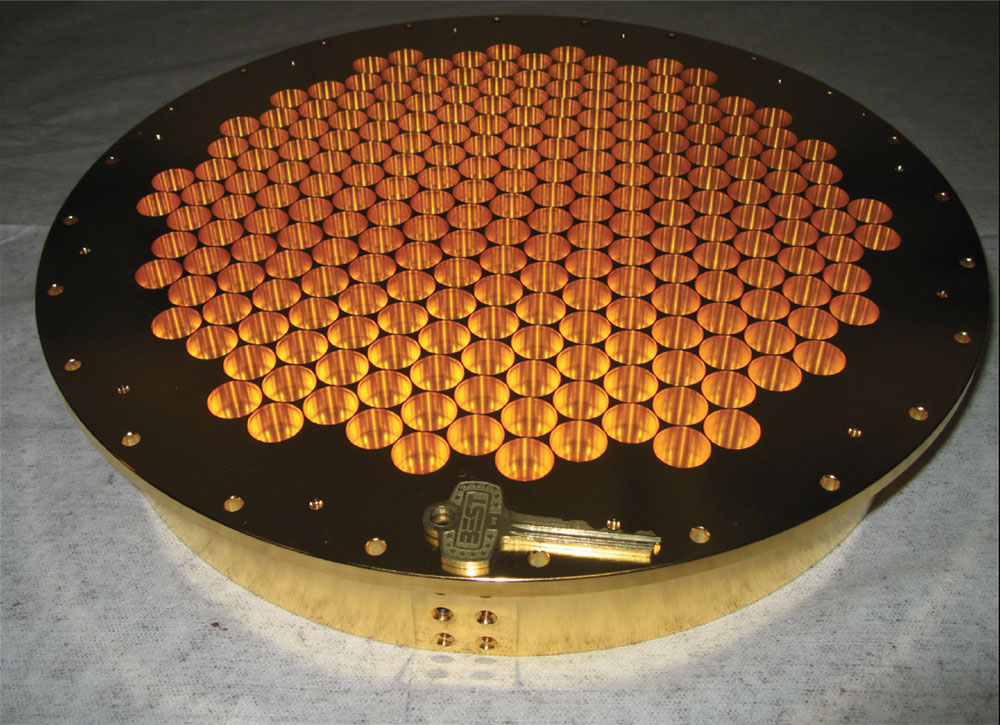
The MUSTANG-2 array of 223 feed horns, which are machined out of a single aluminum block that has been gold-coated. Dual-polarization detector modules are affixed to each feed.
[click to enlarge]
In December 2014, a new bolometer camera (MUSTANG-2) was installed on the NRAO Green Bank Telescope (GBT). This camera employs many of the technologies used in its predecessor – MUSTANG, used by GBT observers from 2009 to 2013 – including Transition Edge Sensor (TES) bolometers; Superconducting QUantum Interference Device (SQUID) amplifiers to read out the detectors; a low-vibration pulse tube refrigerator; and closed-cycle helium-3 and helium-4 refrigerators to cool the detectors to 300 mK.
MUSTANG-2 features many improvements: more sensitive microstrip- and feedhorn-coupled TES bolometers; a wider (75-105 GHz) band pass; a 5x larger instantaneous field-of-view; and much more robust cryogenic performance. Readout is accomplished via four ROACH boards using a microwave-resonator multiplexer that has been adapted for use with TES detectors. The receiver has been designed to accommodate 223 dual-polarization detectors, and the full 223 feedhorn detector array has been fabricated and deployed on the GBT (Figure 1). Available funding permitted populating only 64 of the 223 feeds; the current version of the instrument has thus been dubbed MUSTANG-1.5.
Similar to its predecessor, MUSTANG-2 will have a ~8.5" (FWHM) beam when used on the GBT. It is available for early science observing in collaboration with the instrument team. Commissioning is ongoing and we expect that early science observing will begin in late January 2015. MUSTANG-2 will excel at making high-resolution images of the Sunyaev-Zel'dovich effect, and mapping the large-scale context of star formation in our own Galaxy and nearby galaxies.
Potential Improvements to the GBT X-band System
NRAO is considering implementing a number of changes to improve the reliability of the Green Bank Telescope (GBT) X-band receiver. The changes would provide a more reliable cryogenics system, new amplifiers, and possibly an extension of the available frequency range to 8-12 GHz. If you are interested in this process, and/or have additional changes you would like to see with the GBT X-band system, please contact Toney Minter.
NRAO Summer Student Awarded Chambliss Medal
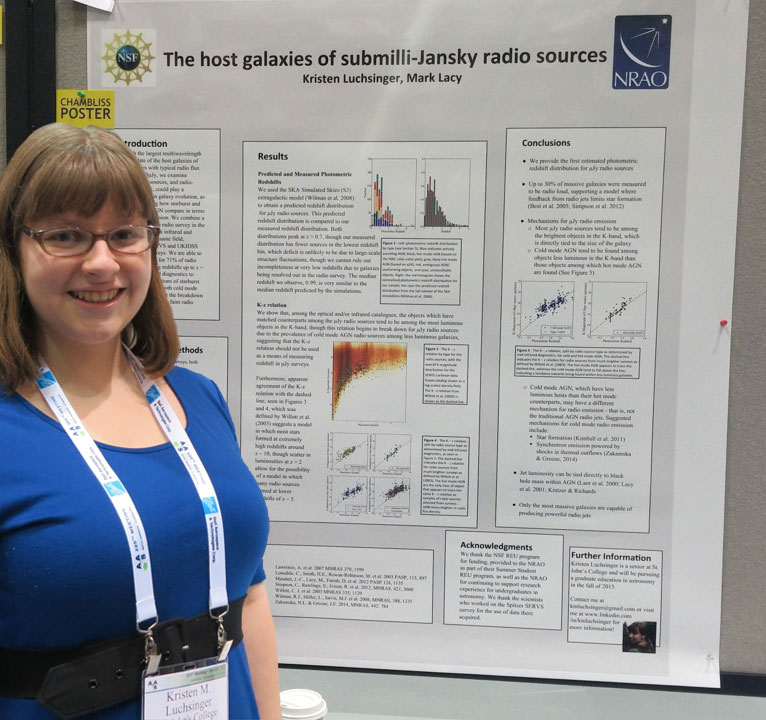
Kristen Luchsinger at the Seattle AAS Meeting.
[click to enlarge]
The Chambliss Astronomy Achievement Student Awards are given to recognize exemplary research by undergraduate and graduate students who present poster papers at American Astronomical Society (AAS) meetings. Awardees are honored with a Chambliss medal or, in the case of an honorable mention, a certificate.
At the January 2015 AAS meeting in Seattle, undergraduate Kristen Luchsinger (St. John’s College) was awarded a Chambliss Medal for the research she conducted as a participant in the 2014 NRAO Summer Student Research Assistantships program. In collaboration with NRAO Scientist Mark Lacy, Kristen studied the host galaxies of faint, sub-milliJansky radio sources. Kristen combined a deep 1.4 GHz radio survey in the Lockman Hole with infrared and optical data in the same field to make the largest study to date of the redshift distribution, brightnesses – determined via the relation between the near-infrared K-magnitude of the host galaxy and redshift – and stellar masses of the hosts of sources with typical radio flux densities ∼100 μJy.
Kristen used mid-infrared diagnostics to show that this μJy radio source population contains a roughly equal mix of star-forming galaxies, low accretion rate, radio-loud AGN, and high accretion rate AGN (Seyfert galaxies and radio quiet quasars). Using these classifications, Kristen demonstrated that, like their radio-bright counterparts, micro-Jansky radio sources are hosted in galaxies with high stellar luminosities, but only the low accretion rate, radio-loud objects are hosted by galaxies as luminous as those that host the very radio-luminous objects that dominate surveys at bright radio flux limits ~0.1-1 Jy.
Congratulations to Kristen!
Recent Media Releases
Career Opportunities
New Postings
Technical Specialist I: The NRAO in Socorro, NM is now accepting applications for a Technical Specialist I. The technician will assist with fabrication, installation and maintenance of cryogenic (very low temperature) refrigeration equipment, vacuum systems, and support the Front End receiver group. The technician will assist with the day-to-day operation of the Very Large Array (VLA) and Very Long Baseline Array (VLBA) maintenance programs. Some in-house training will be provided.
Post Doc: The NRAO in Green Bank, WV is now accepting applications for a Post Doc. The NRAO is looking for an energetic person to join the scientific staff in Green Bank. The successful applicant will have 50% of his/her time available for independent research, while 50% of his/her time will be devoted to support of the Green Bank Telescope (GBT) and GBT observers. The support duties will vary according to the skill set and interests of the successful applicant as well as general support for GBT observers.
Technical Specialist II: The NRAO in Socorro, NM is now accepting applications for a Technical Specialist II. Under general supervision from scientists and engineers, the Technical Specialist II assembles, calibrates, tests, analyzes, troubleshoots and/or repairs the Digital Transmission System and Receiver modules built for the Atacama Large Millimeter/submillimeter Array (ALMA) project along with some additional work on related hardware for the Very Long Baseline Array (VLBA) and Very Large Array (VLA). Work performed is moderately independent. This is the middle level of three progressively more complex positions.
Contracts and Procurements Manager: The NRAO in Charlottesville, VA is now accepting applications for a Contracts and Procurements Manager. The candidate will be responsible for the management and operation of the Observatory purchasing and contracting division functions. The candidate will also be responsible for the development and implementation of Observatory-wide procurement policies and procedures.
Safety Officer: The NRAO is now accepting applications for a Safety Officer in Socorro, NM. The Safety Officer is responsible for ensuring compliance with applicable Federal, State, and local Environment, Safety, and Security (ES&S) regulations for the NRAO at the Very Large Array (VLA). This Safety Officer will also provide the management, presentation, and implementation of Safety and Health Programs that maintain employee awareness.
Track Equipment Operator I: The NRAO is now accepting applications for a Track Equipment Operator 50 miles west of Socorro, NM. Under specific guidelines and directions from the group supervisor or lead operator, the candidate will perform a variety of tasks involving construction, loading, lifting, installation, and maintenance of track system and regularly assists in the maintenance and repair of heavy equipment involving work related to the over 40 miles of double tracks and standard gauge used to reconfigure the antennas.
Observatory Scientist: The Joint ALMA Observatory (JAO) is seeking an Observatory Scientist with extensive experience for coordinating and organizing scientific activities at the Atacama Large Millimeter/submillimeter Array (ALMA) radio astronomy observatory in Santiago, Chile. The Observatory Scientist will provide ongoing scientific leadership for astronomy staff, and continue to lead the efforts to maximize the scientific performance and impact of the array through continued improvement including, but not limited to, the development program.
Scientist (Assistant/Associate): The NRAO in Charlottesville, VA is now accepting applications for a Scientist position. The staff scientists recruited for these positions are expected to facilitate and enable cutting-edge science by community members and work to enhance the observing capabilities for ALMA. The ideal candidates will contribute to the overall NRAO mission and must be able to demonstrate success working within a collaborative environment that promotes motivation, leadership, and team building.
Astronomer (Tenure Track): The NRAO in Charlottesville, VA is now accepting applications for an Astronomer position. NRAO is recruiting for a tenure-track scientific staff position (Astronomer track) affiliated with the North American ALMA Science Center (NAASC). The NAASC is the science operations division of North American ALMA. The successful candidate shall have demonstrated excellence in research and research leadership, and demonstrated the ability to provide vision and leadership for development of new ALMA and NRAO concepts, enhancements, and next-generation directions.
Software Engineer: The NRAO in Green Bank, WV is now accepting applications for a Software Engineer position. The candidate will use prescribed methods, research, and conduct and/or coordinate detailed phases of software engineering work as assigned. The candidate will perform work that involves conventional software engineering practices.
From the Archives
Ellen Bouton

[click to enlarge]
About this month's photograph: On 30 January 1974, following several years of discussion on transporter requirements and possible designs (both within NRAO and with outside firms), E-Systems Inc. was awarded the contract for design and fabrication of transporter #1 for the Very Large Array (VLA).
The transporter was crucial to making the VLA a flexible instrument that could operate in multiple array configurations. An 11 February 1977 memo states, "We tend to underestimate the complexity of the design and construction of the vehicle, which picks up 220-ton antennas and transports them through 90 [deg] intersections. That it works as well as it does is an engineering achievement of the first order..."
Transporter #1 was named Hein's Trein, honoring long-time NRAO Associate Director Hein Hvatum.
From the Archives is an ongoing series illustrating NRAO and U.S. radio astronomy history via images selected from our collections of individuals' and institutional papers. If readers have images they believe would be of interest to the Archives, please contact Ellen Bouton.

